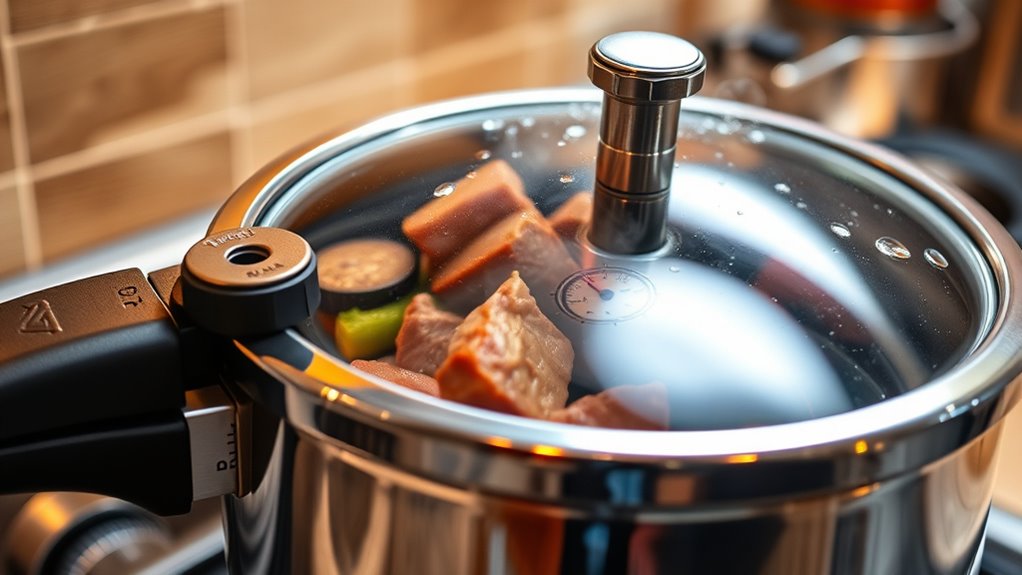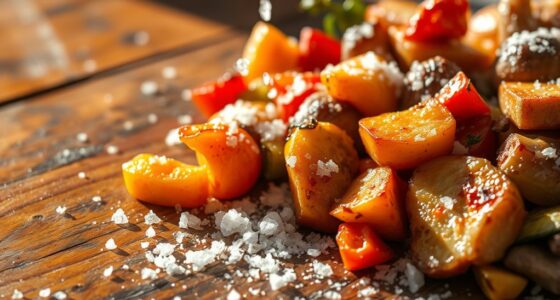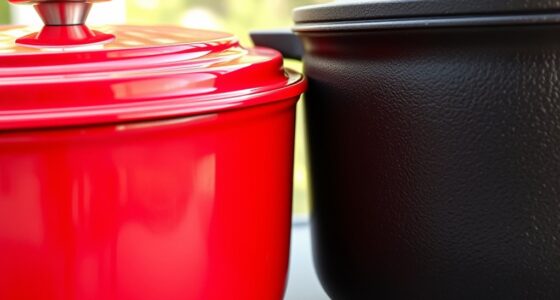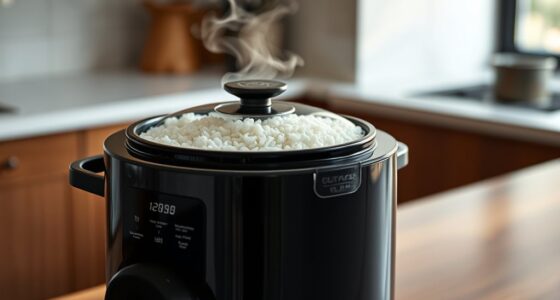Pressure cooking tenderizes food by raising water’s boiling point, allowing higher temperatures without evaporation. This accelerates the breakdown of connective tissues like collagen into gelatin, making meats softer. The sealed environment traps steam, ensuring even heat transfer and faster cooking. Higher pressure speeds up this process while preserving flavors and nutrients. To discover more about how these factors work together, keep exploring how pressure impacts tenderization and cooking efficiency.
Key Takeaways
- Elevated pressure raises water’s boiling point, allowing higher cooking temperatures without boiling away moisture.
- Higher temperatures accelerate collagen breakdown into gelatin, tenderizing tough cuts of meat efficiently.
- Increased pressure speeds heat transfer, ensuring even cooking and rapid softening of connective tissues.
- Faster cooking preserves nutrients and enhances flavor through quicker Maillard reactions and minimal nutrient loss.
- Proper pressure levels and cooking times optimize collagen hydrolysis, resulting in juicy, tender, and flavorful dishes.
The Role of Elevated Pressure and Temperature in Tenderizing Food
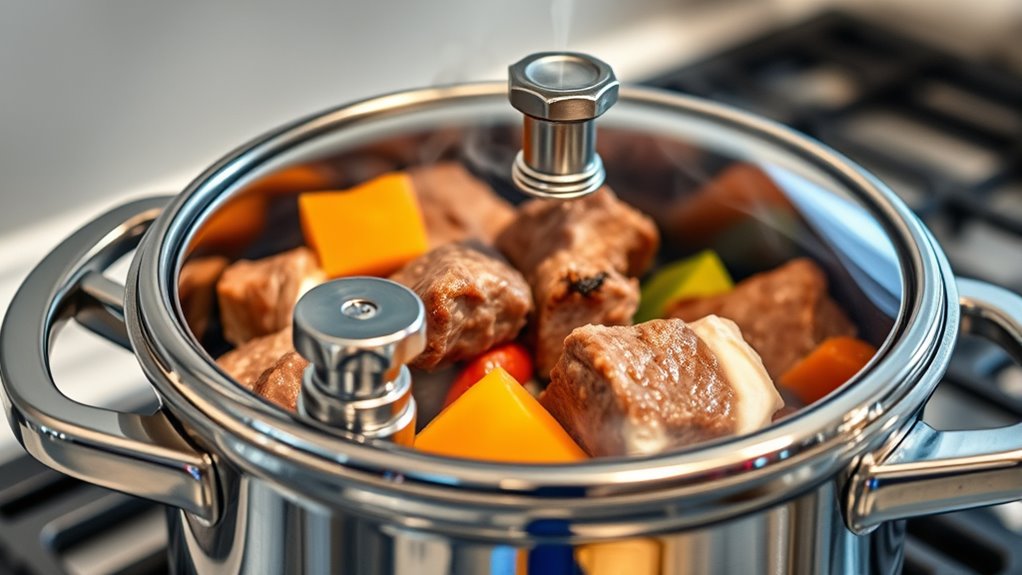
Elevated pressure and temperature in a pressure cooker play a crucial role in tenderizing food. Inside, increased pressure raises the boiling point of water from 212°F to about 250°F, allowing higher cooking temperatures. This elevated temperature speeds up the breakdown of connective tissues like collagen, turning them into gelatin and tenderizing tough cuts. The theory behind this is that higher heat causes proteins and fibers to denature more rapidly, softening the food’s texture. The sealed environment traps steam, ensuring heat penetrates evenly and efficiently. Additionally, the pressure buildup enhances the cooking process by increasing the rate of heat transfer within the cooker. As a result, the pressure cooker accelerates the tenderization process by combining high pressure, elevated temperature, and steam inside. This synergy makes tough ingredients easier to chew and digest, highlighting how pressure and temperature work together to transform your meals.
How Water’s Boiling Point Changes Under Pressure
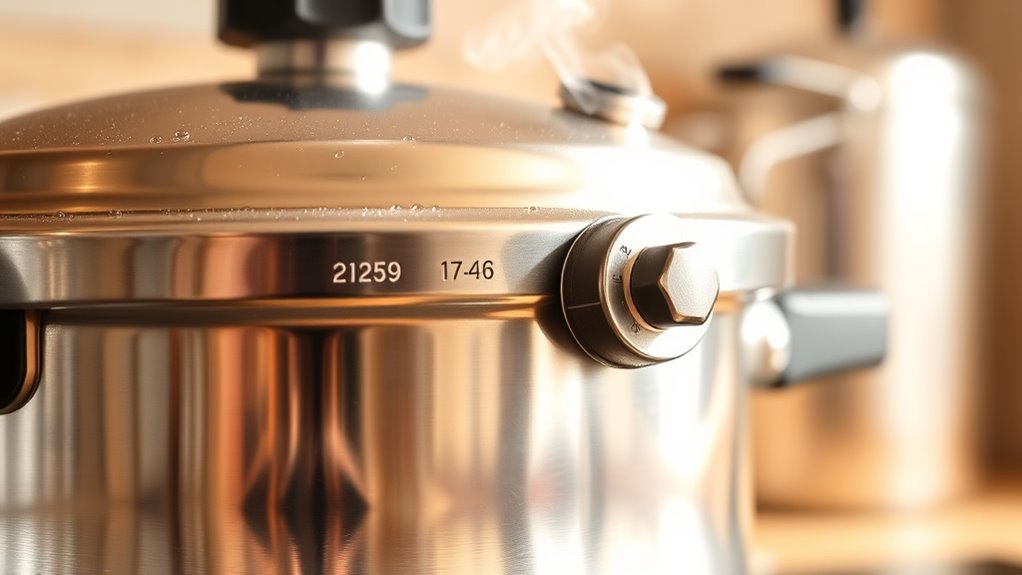
When you increase the pressure inside a pressure cooker, water’s boiling point rises above 212°F. This means you can cook at higher temperatures without boiling away the water. Understanding how pressure impacts boiling helps you use your pressure cooker more effectively. Additionally, awareness of security system effectiveness can inform decisions about home safety during cooking or other activities. This knowledge underscores the importance of pressure cooking benefits, which can motivate you to approach cooking with confidence and patience. Recognizing cooking safety practices ensures a safer and more efficient culinary experience. Moreover, understanding protective styling benefits can help you choose the best techniques to maintain your hair health while cooking or during other daily activities.
Elevated Boiling Temperatures
In a pressure cooker, increasing the pressure raises the boiling point of water well above its standard 212°F (100°C). This phenomenon occurs because the internal pressure influences water molecules, allowing them to reach higher temperatures before boiling. During pressure cooking, the pressure increase inside a sealed pressure cooker elevates the boiling point of water to about 250°F (121°C). This higher boiling point creates elevated temperatures that cook food faster and more efficiently. Because the temperature inside the cooker exceeds normal boiling, tough cuts of meat and connective tissues break down more quickly, tenderizing the food. The relationship between pressure and boiling temperature follows the principles of physics, ensuring that water remains a hot liquid at these elevated temperatures, making pressure cooking effective. Additionally, understanding the boiling point of water under pressure helps explain why pressure cooking is such a powerful method for tenderizing food. This knowledge of pressure-temperature relationships enhances the overall understanding of the cooking process. The science behind pressure is fundamental to optimizing cooking times and achieving desired textures. Furthermore, research into thermal dynamics explains how heat transfer efficiency increases during pressure cooking, contributing to faster cooking times and better results. Recognizing the impact of pressure on heat transfer can help cooks fine-tune their techniques for optimal results.
Impact of Pressure Levels
As pressure inside a pressure cooker increases, water’s boiling point rises above the standard 212°F (100°C). This means that at higher pressure levels, water can reach temperatures around 250°F (121°C), cooking food faster and more efficiently. Here are three key points to understand:
- Increased pressure compresses water vapor, allowing water to boil at higher temperatures without turning into steam.
- The higher temperature under high pressure accelerates tenderizing, breaking down tough fibers quickly.
- When pressure drops, the boiling point lowers, and water returns to 212°F, reducing cooking speed.
- Maintaining optimal pressure levels helps ensure the preservation of spiritual energy within the cooking environment, promoting a harmonious and nourishing experience, which can also enhance the overall culinary quality.
- Understanding the pressure dynamics involved in cooking can help optimize the process for better flavor and texture outcomes.
- Proper regulation of pressure is essential to prevent thermal runaway, ensuring safety and consistent results during cooking.
- Additionally, awareness of AI security principles can aid in developing smarter, safer pressure cooking devices that adapt to changing conditions for optimal performance.
The Molecular Breakdown of Collagen and Connective Tissues
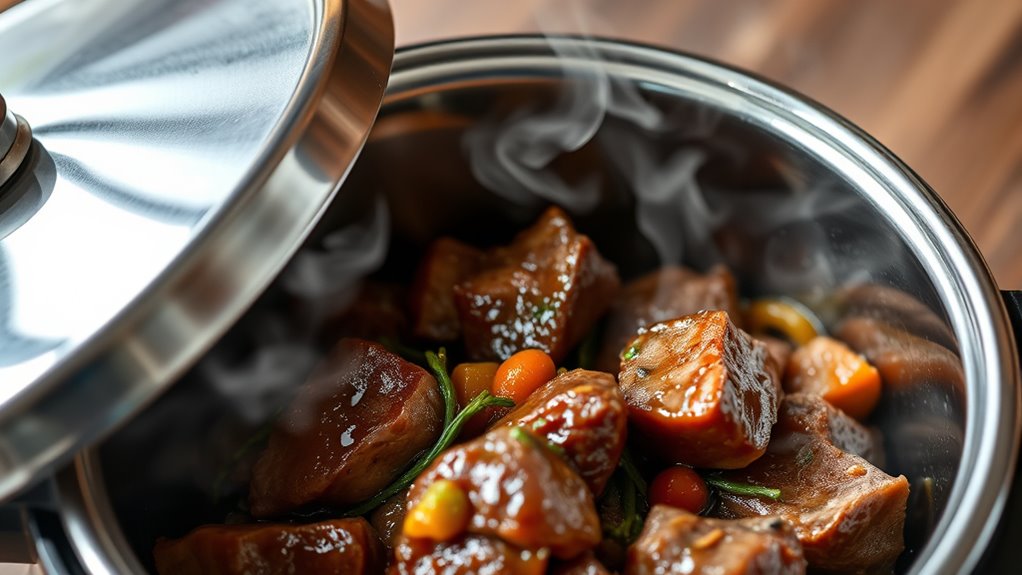
Pressure cooking accelerates the molecular breakdown of collagen and connective tissues by raising internal temperatures well above boiling point. When heat energy penetrates the meat, collagen begins to hydrolyze into gelatin at temperatures above 160°F (71°C). This process involves denaturation, where structural proteins lose their original form, making the tissue more tender. The high-pressure environment helps water infiltrate connective tissues more effectively, speeding up hydrolysis and breaking down tough fibers quickly. As collagen transforms into gelatin, it enhances moisture retention and creates a melt-in-your-mouth texture. This breakdown not only tenderizes the meat but also enriches its flavor, making pressure-cooked dishes rich and succulent. The combined effects of heat, moisture, and pressure ensure rapid and thorough protein transformation. Regular use of moisture-retaining techniques can further improve the tenderness and juiciness of pressure-cooked foods by optimizing meat hydration. Additionally, the presence of moisture facilitates the hydrolysis process, further aiding in tenderization.
The Impact of Rapid Cooking on Flavor and Nutrients

Rapid cooking in pressure cookers helps preserve water-soluble vitamins like C and B by limiting heat and water exposure. It also boosts flavor through faster Maillard reactions at higher temperatures, making meals tastier in less time. Plus, shorter cooking reduces nutrient loss, resulting in more nutritious, flavorful dishes. Additionally, the use of durable materials in pressure cookers ensures safety and longevity during high-pressure cooking. The nutrient retention process is further enhanced by the sealed environment, which minimizes oxygen exposure and prevents oxidation of sensitive nutrients. This controlled environment encourages efficient energy transfer, leading to better preservation of both nutrients and flavors. Moreover, the rapid cooking process helps maintain the integrity of delicate textures, ensuring foods stay tender without overcooking.
Nutrient Preservation Benefits
Cooking with a pressure cooker helps preserve nutrients and flavor by markedly reducing cooking time. This rapid cooking process minimizes heat-sensitive nutrients like vitamins C and B complex from degrading. Additionally, the sealed environment prevents water contact, reducing leaching of water-soluble nutrients, vitamins, and minerals, which preserves the food’s natural flavor and nutritional profile. Here are three key benefits:
- Retention of heat-sensitive nutrients — less cooking time means fewer vitamins and minerals are lost.
- Minimized leaching — the sealed environment keeps nutrients in the food, not in the cooking water.
- Enhanced nutritional quality — faster cooking limits oxidation and nutrient breakdown, maintaining antioxidants and phytochemicals.
- Incorporating vibrational energy techniques from the Law of Attraction can further optimize nutrient retention by promoting a positive mindset during cooking, which may influence the food’s energetic quality.
Flavor Enhancement Mechanisms
Have you ever noticed how pressure cooking can make dishes taste more vibrant and flavorful? The secret lies in how pressure influences flavor enhancement mechanisms. Because of the high pressure, water boils at a higher temperature, allowing ingredients to develop richer flavors without overcooking. The sealed environment traps steam infused with extracted flavors, resulting in concentrated flavors and a more intense taste. Rapid cooking reduces oxidation and evaporation, preserving volatile flavor compounds that might otherwise be lost. Additionally, the elevated temperatures accelerate Maillard reactions, creating browning and depth in meats and vegetables. This combination of factors enhances the overall flavor profile, making your dishes taste fresher, more robust, and remarkably satisfying—all thanks to the unique environment pressure creates.
Cooking Time Advantages
Because pressure cooking substantially cuts down on overall cooking time—by approximately 30% to 50%—you can develop rich flavors more quickly without compromising quality. The high pressure raises the temperature inside the cooker, accelerating chemical reactions like browning and flavor development. Faster cooking minimizes nutrient loss, especially water-soluble vitamins like C and B-complex, because less water and time are involved. Additionally, the pressure environment reduces nutrient leaching into the water, keeping more nutrients in your food. Here are three key benefits:
- Enhanced flavor through rapid temperature increase and steam.
- Nutrient retention due to shorter cooking times and minimal water contact.
- Reduced formation of harmful compounds by limiting heat exposure during pressure and quick pressure release.
Comparing Pressure Cooking to Traditional Methods
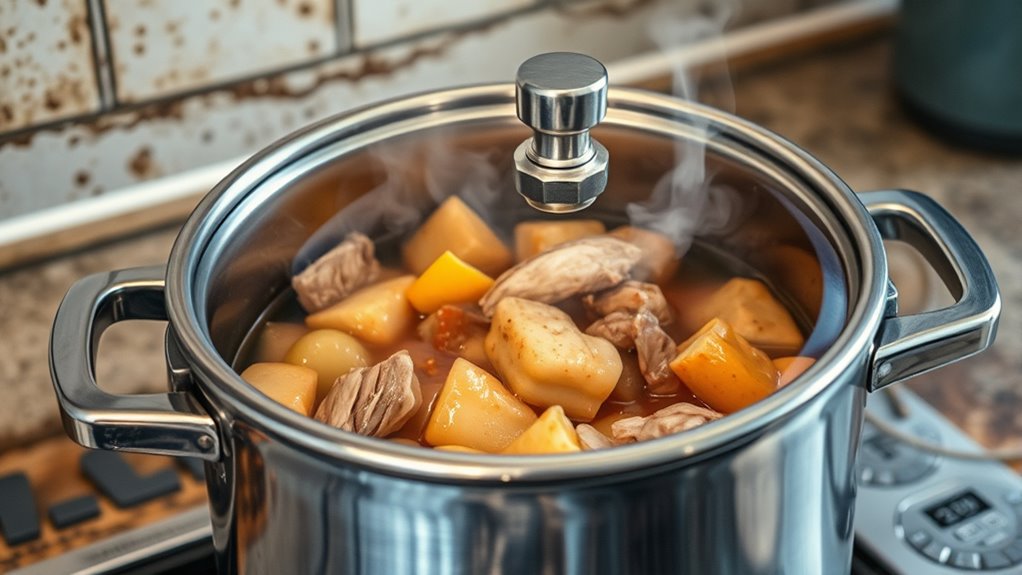
Pressure cooking markedly outpaces traditional methods when it comes to tenderizing tough foods, thanks to its higher operating temperature. By increasing the pressure inside the cooker, water’s boiling point rises to about 250°F (121°C), well above the 212°F (100°C) limit of conventional boiling. This higher temperature accelerates tenderization by breaking down collagen into gelatin more efficiently. The sealed environment traps steam and moisture, ensuring consistent heat transfer and preventing water and heat loss. Unlike open-pot cooking, which may take hours to soften tough cuts, pressure cooking achieves similar results in 30-60 minutes. The combination of high pressure and temperature makes collagen conversion faster, producing tender, flavorful dishes much more quickly than traditional boiling or simmering techniques.
Practical Tips for Maximizing Tenderness With Pressure Cooking
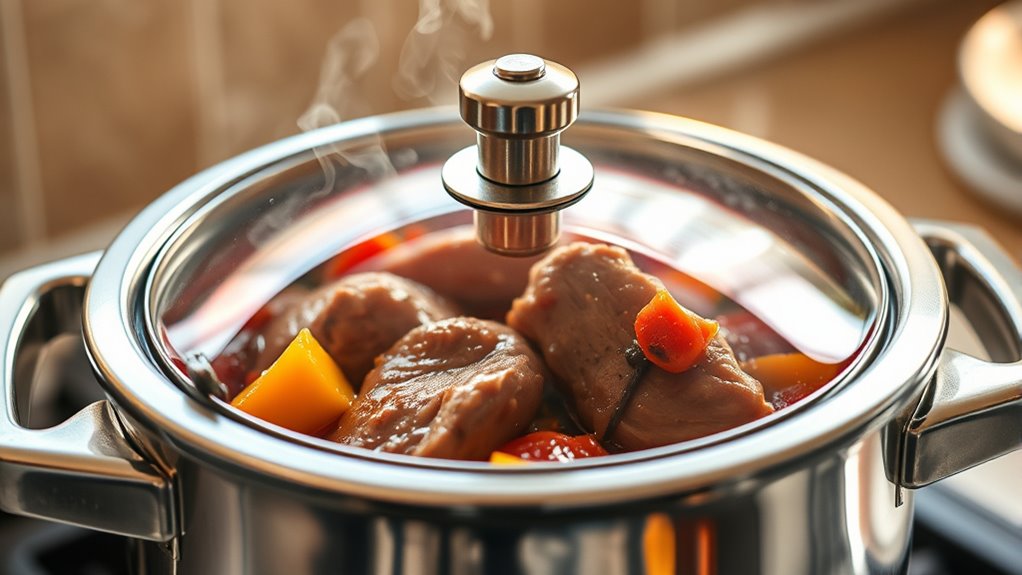
To maximize tenderness when pressure cooking, start by guaranteeing you use enough liquid—at least one cup of water or broth—to generate sufficient steam. This steam creates the heat needed to break down collagen and tenderize tough cuts. Next, follow these tips:
- Cook at the recommended pressure (usually 15 psi) for the right duration (20-30 minutes) to optimize collagen breakdown and tenderness.
- Cut meat into smaller, uniform pieces before cooking to ensure even heat distribution and consistent tenderness.
- Let the pressure release naturally for 10-15 minutes, which prevents toughness caused by rapid temperature shifts and maintains ideal tenderness.
Using these techniques, you’ll enhance your pressure cooking results by improving steam efficiency, regulating temperature, and preserving moisture.
Frequently Asked Questions
How Does Pressure Cooking Tenderize Meat?
You wonder how pressure cooking tenderizes meat. When you cook under high pressure, the temperature rises above boiling point, breaking down tough connective tissues like collagen into gelatin. This process speeds up the softening of muscle fibers and proteins, making the meat much more tender. Plus, the sealed environment traps moisture, ensuring even cooking, juiciness, and flavor, all in a shorter amount of time than traditional methods.
What Is the Science Behind Pressure Cooking?
Imagine if Galileo had a pressure cooker—science still explains how it works! Pressure cooking increases the internal pressure, raising water’s boiling point above 212°F. This speeds up heat transfer, breaking down tough proteins and fibers faster. The elevated pressure also boosts chemical reactions, like browning, and creates molecular collisions that make food tender and moist. It’s all about the ideal gas law working in your kitchen.
What Is the Law Behind the Pressure Cooker?
The law behind a pressure cooker is based on the ideal gas law, PV=nRT. When you seal the cooker, pressure rises as steam molecules collide more forcefully and frequently. This increased pressure raises the water’s boiling point, allowing food to cook at higher temperatures. Safety valves release excess steam to maintain safe pressure levels, ensuring your cooker operates correctly and efficiently, tenderizing food faster.
Why Is My Beef Still Tough in the Pressure Cooker?
If your beef is still tough in the pressure cooker, it’s likely because it didn’t cook long enough or at the right pressure. You need to guarantee the temperature stays around 250°F and cook for at least 30-45 minutes to break down collagen properly. Also, avoid rapid release of pressure, as it can tighten the fibers. Letting the meat rest afterward helps it become even more tender.
Conclusion
Just like a skilled sculptor reveals the beauty hidden within marble, pressure cooking transforms tough cuts into tender masterpieces by breaking down connective tissues. Imagine a stewing pot bubbling away, turning a tough piece of meat into melt-in-your-mouth goodness in less time than traditional methods. Embrace the science behind it, and you’ll uncover delicious, perfectly tender dishes every time—saving you effort and enhancing flavor, all thanks to the magic of pressure and heat working together.
